The snake plant (a.k.a mother-in-laws-tongue) is a resilient houseplant succulent that offers a handy range of health benefits.
It can convert carbon dioxide into oxygen whilst you sleep, and it can also assist in the removal of toxic indoor household pollutants such as formaldehyde and benzene and also filter out certain nasty impurities such as xylene, trichloroethylene, toluene, and ammonia.
In 1989, an experiment was completed by NASA that concluded plants with a larger leaf area have the ability to process better quality air and more of it.
Snake plants are one of those plants that are right up there with the best of them. Therefore, learning how to make snake plants grow tall has its own benefits.
In this article, we’ll walk through all of the steps to grow your snake plant tall, strong and healthy so you can enjoy all of their benefits. Sound good? Let’s go!
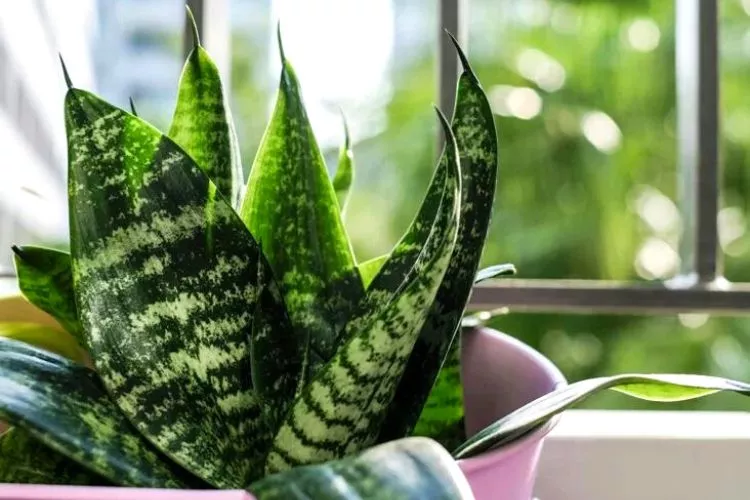
Table of Contents
How to Make Snake Plants Grow Tall (Step by Step Guide)
It’s common knowledge that taller snake plants have the ability to purify more air and remove harmful toxins, leaving its surrounding area clean and fresh.
Let’s have a look at the process involved of how to make snake plant grow tall, so that you can also reap the benefits.
Understanding the Snake Plant’s Growth Habits
The first and most important step is to understand exactly how snake plants grow in their natural habitat. Then we need to try to emulate the growing conditions as best we can so they can grow and thrive without any kind of hindrance.
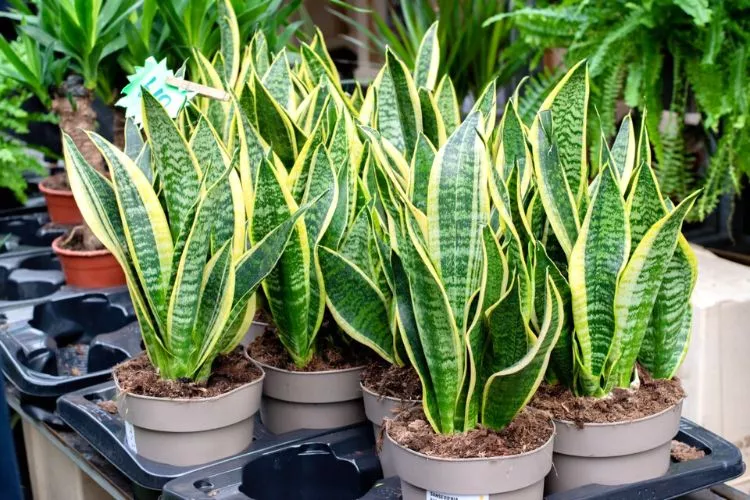
Overview of the snake plant’s natural growth habits
Snake plants are found in dry, rocky areas of tropical West Africa, particularly from Eastern Nigeria to the Congo. They receive quite a bit of sunlight but can also benefit from moments of shade to recover and protect them from extreme heats. They grow in well draining sandy textured soil and don’t fare too well when given too much water.
Factors that affect the snake plant’s growth
There are a few prime factors that affect the growth of a snake plant. These include:
- Exposure to sunlight: They prefer bright, indirect light but are also known to tolerate some direct sunlight.
- Forcing growth: Keeping them in a smaller growing container for that little bit longer to force slight root bounding. We will get to that a little further into the article.
- Fertilization: can also give them the kick they need to put on some real upward size.
- Correct water usage: Given that snake plants are succulents, they absorb a lot of their moisture from the atmosphere. Therefore, overwatering them can cause troublesome issues such as nutrient deficiencies via suffocation and root rot.
How to determine if a snake plant is healthy?
A healthy snake plant will have dark green leaves that are firm, lush and unspoiled with spotting or discolored tinges.
When a snake plant is suffering from any kind of environmental stress, they will become faded and discolored and present spots, wilting and dropping of leaves. They may even smell around the soil area if the roots have begun to rot out.
How to identify when a snake plant needs to be repotted?
Snake plants can get a real growth boost when you leave them in their growing container for that little bit longer. Cramping them will force upward growth.
When keeping them in a smaller pot, the roots will become bound and create a ball which shoots the roots in all directions.
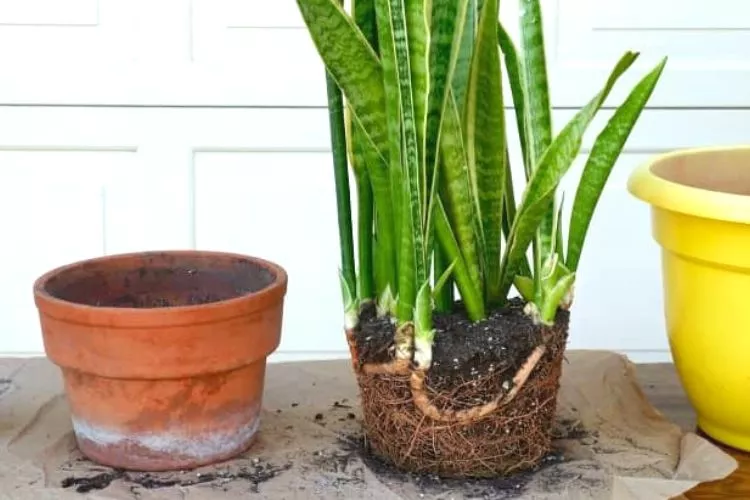
However, there will come a time when they need to be repotted. The signs you need to look for are when the roots slowly start making their way to the bottom of the pot as well as popping out the top around the stem.
Proper Soil and Potting
Ensuring that your snake plant is planted in an appropriate soil and growing container are important initial steps that should not be overlooked. Getting this step right is crucial to the longevity and upward growth of this type of plant.
The ideal soil for snake plants
In their natural habitat, snake plants grow in fast-draining, sandy textured soil. So, providing them with a similar type will allow them to grow to their full potential. Ideally, it’s best to purchase or self blend a light loamy soil that sits between 5.5 to 7.0 on the pH scale.
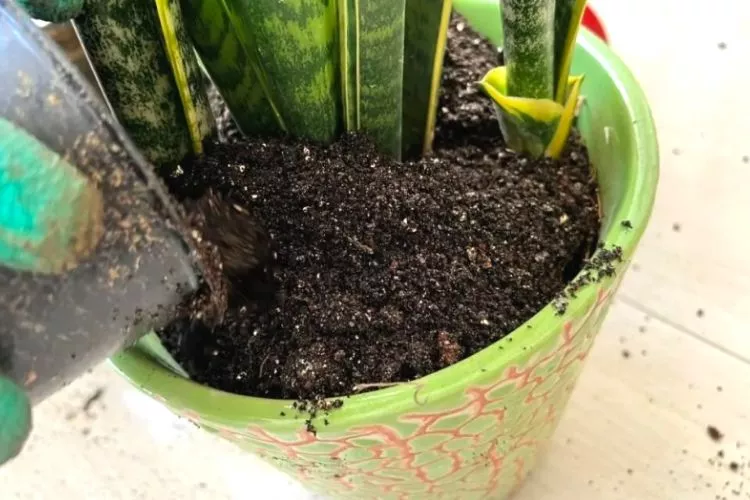
If you want to make your own then a simple and effective mix can be created by using the following materials:
- 1 part inorganic matter (coarse sand, perlite, pumice, etc)
- 2 parts organic materials (coco coir, peat moss, etc)
- 3 parts garden soil or potting mix.
The best potting materials for snake plants
Alongside a base potting mix, a snake plant has 3 main requirements when it comes to the type of complimentary potting materials it prefers. Let’s have a look at those and some examples of what can be used to create the perfect blend.
- Adequate drainage and airflow – Perlite, pumice, gravel, small rocks/pebbles, activated charcoal, sand, etc. These materials should be slightly coarse and jagged to ensure that any moisture can glide on by without being absorbed or cause clumping.
- Nutrient rich – Coco coir, peat moss, fine cactus compost blends, etc. The key to adding these types of materials is to avoid clumping which restricts airflow and drainage. There are many nutrient rich materials to choose from but the ones mentioned above are more suited to the snake plant.
- Keep in mind that a snake plant doesn’t require too much in the way of fertilization so a finer compost blend is adequate. Again, avoid composts that are thick and restricting.
- Aeration – Again, materials such as perlite, gravel, grit, and sand are beneficial for aeration, especially around the roots. The better they can breathe, the taller they can grow.
How to repot a snake plant to encourage growth?
The best way to approach the repotting process of a snake plant to encourage growth is to allow it to continue to grow in a smaller container. This will ensure that the roots begin to form a ball on the inside of the pot.
As the roots form their ball, there are more roots to soak in moisture and nutrients which force the plant to grow upwards.
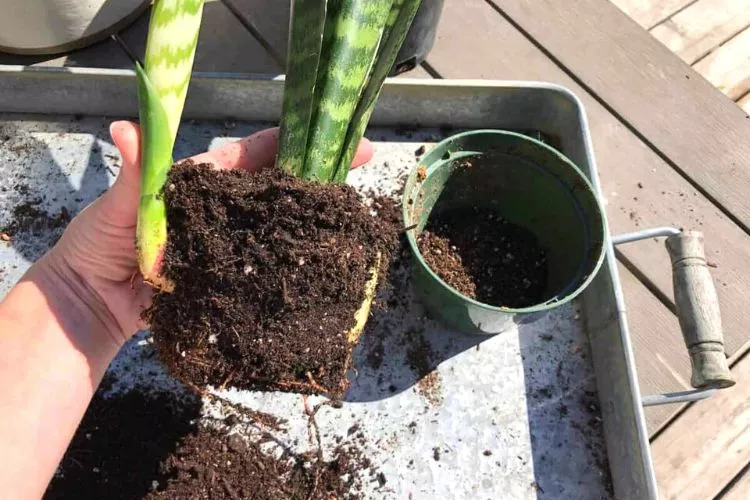
However, once the roots start to poke out the bottom of the container or top of the soil, the plant should be repotted to a container that is slightly larger. Terra cotta pots are ideal as they offer supreme breathability and drainage.
Keep in mind that snake plants grow up to 12 feet tall and 10 feet wide once fully mature. At this point, they require a container that is around 18 inches in diameter and 24 inches deep
How to ensure proper drainage?
Adequate drainage can be achieved by using materials and containers that accommodate this requirement. Coarse materials such as perlite, pumice, gravel, small rocks/pebbles, activated charcoal, sand, etc are great for drainage.
Containers with drainage holes that are porous and allow breathability like terracotta or clay are better suited to the snake plant.
Watering and Fertilizing
Watering and fertilization are not something that snake plants need a lot of, however, there are a few things to think about when planning any kind of schedule relating to these factors.

How often to water snake plants?
The most important thing to think about when watering a snake plant is to always check on the moisture content before administering any water. Snake plants don’t need much water as they are succulents.
Succulents absorb moisture from the atmosphere so if they are allowed exposure to the elements then they generally have all of the moisture they require to grow and thrive.
However, if they are located somewhere with arid conditions, they may need to be watered once per fortnight to ensure that they have all the moisture they need to continue on their merry way.
They require much less during the winter months. Again, depending on their geographic location, they should receive smaller amounts of water once per month or every 2 months.
The best way to test the moisture content is by sticking a finger down the side of the stem into the soil and ascertaining whether or not the soil is dry. If it’s bone dry then it’s ok to administer water at a low frequency.
At the end of the day, a snake plant can develop root rot much easier than other plants due to its strong need for adequate drainage and aeration. If the soil is not prepared correctly and the wrong type of container is used, the problems become amplified which can make the plant suffer a slow death.
How to properly water snake plants to encourage growth?
Snake plants should be given smaller amounts of water with large gaps in frequency. Every 2 weeks in warmer months is ideal, depending on the soil moisture content. The main thing to keep in mind is to never overwater a snake plant. Over watering will cause suffocation around the roots.
This problem disallows nutrients and oxygen which stunts growth. Furthermore, overwatering causes root rot. The roots sit in stagnant water and drown in the excess, undrained water. The rot starts at the roots and works its way up through the plant, killing it as it spreads.
Fertilizing options for snake plants
Snake plants don’t really require much in the way of plant food, if they are growing in a container or location where they don’t have access to the nutrients they require, you can give them a light feed once or twice per year.
One dose can be administered in spring and again in the summertime. The best option is a thin layer of worm castings. Alternatively, you can use an organic all-purpose houseplant 10-10-10 food mix.
Light and Temperature
The light and temperature requirements for a snake plant are extremely important when trying to encourage growth. Adequate light will allow the plant to shoot upwards whereas temperatures that are either too hot or too cold can prevent the growth from occurring as the plant tries to recover from any stress caused.
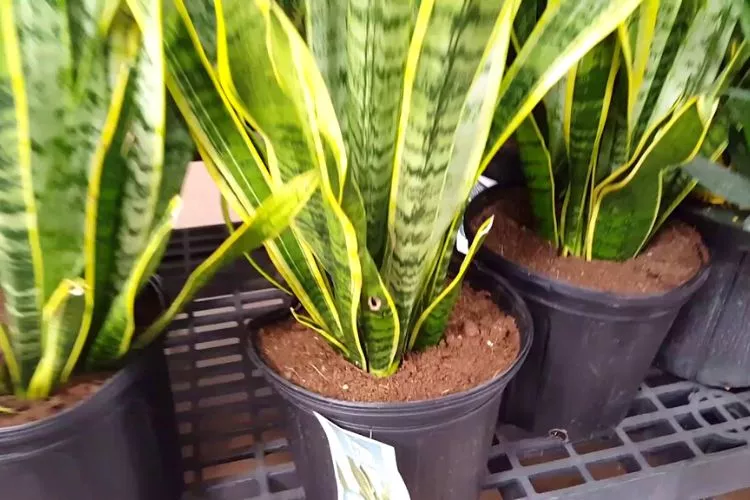
The ideal light conditions for snake plants
Snake plants are used to being exposed to bright, indirect light in their natural habitat. They can be partially covered or shaded by rocks, trees, bushes, etc. So, emulating these conditions is ideal.
They can tolerate slight shading however, they will grow that little bit more slowly as a result. Try to place them in a bright, airy location where they have the chance to soak in the sun’s rays all day long.
How to ensure snake plants are getting enough light?
Depending whether you’re growing your snake plant indoor or out, the exact placement can be vital to ensure it’s chances of growing tall. The best location for a snake plant is on a window sill that faces either east or west. That way they get enough exposure either earlier or later on but not for the whole day.
Southern exposure is also a great option as long as you keep your plant from getting too hot. The lighter the area, the better for the well being of the plant.
Temperature requirements for snake plants
Snake plants thrive best when grown in temperatures between 55-85°F (13-30°C). Relocate them when the mercury drops lower than 50°F (10°C) as they don’t tolerate the cold. When left in these conditions for longer than a few days, they start to show signs of stress. The signs include curling and even mushy yellow to white leaves when left for way too long.
On the other end of the scale, snake plants are much more tolerant to heat but will start to show signs of heat stress around the 100°F (38°C) mark. These signs include dry, wrinkled leaves that can slowly curl inwards and fall off the longer they are exposed to the heat.
How to protect snake plants from extreme temperatures?
The easiest way to protect a snake plant from extreme heats and chills is by simply ensuring that they are located somewhere where they aren’t exposed. Indoors is usually the most ideal spot for them as the temperatures can be much more closely monitored.
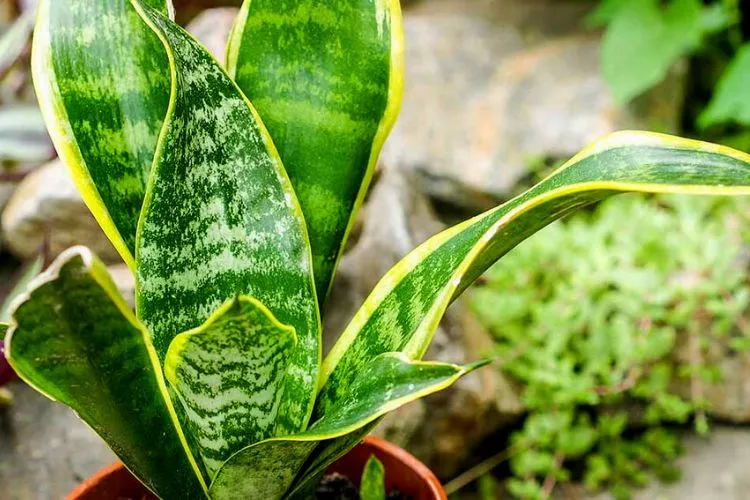
Outdoors has its advantages also but when the weather starts to change, it’s a good idea to get them into some protective cover to mitigate the risks of temperature stress. Some other locations that can offer protection include garages, sheds, covered porches, etc.
Pruning and Propagation
Pruning and propagating snake plants are important processes in ensuring growth and continuity. As long as you understand their growth patterns, these processes can be put into action without much thought.
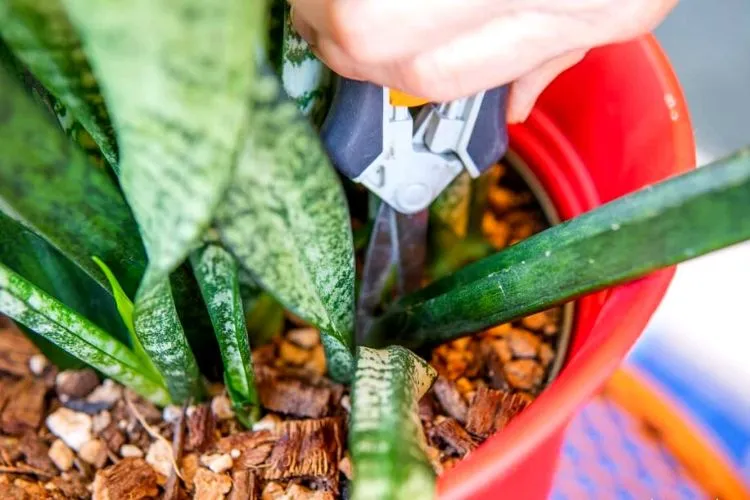
How and when to prune snake plants?
Snake plants should be pruned and shaped if you want them to grow tall. Otherwise, they will focus their energy on producing more leaves instead of longer leaves. Doing so will also help to maintain the size, without having to move them to a larger container earlier than necessary.
The best way to prune a snake plant is by first getting yourself a decent pair of clean, sterilized scissors or shears. Then do the following:
- Have a rough idea of how you want your snake plant to look. This way you can prune accordingly without removing any unnecessary parts that can steer away from that exact look.
- Remove any dead or decaying leaves by cutting them close to the top of the soil line, leaving at least 1 cm. Try to make clean, straight cuts as jagged edges are an open invitation to pests and diseases.
- When it comes to shaping, start from the outer edges and remove any leaves that are limp and hang outside the desired radius.
- Once you have your diameter complete, go on to prune for height. Start with the tallest leaves first and trim them down to the desired height and work your way through each leaf individually.
- By this stage, you should have a compact, uniform snake plant with a few stubby looking leaves as well as some pointy ends. Don’t stress too much about the stubby leaves as once the pointed ones grow taller, they will also need pruning and everything will end up looking the same at that stage.
Routine pruning should take place every 2-3 years. They have quite a slow growth rate and assuming you cut them back to around 2/3 ‘s of their overall height, this time frame can usually be relied on.
How to propagate snake plants from cuttings?
Snake plants are reasonably easy to grow from cuttings, however, the process isn’t a fast one. If you think about the slow growth rate then you know what to expect when propagating.
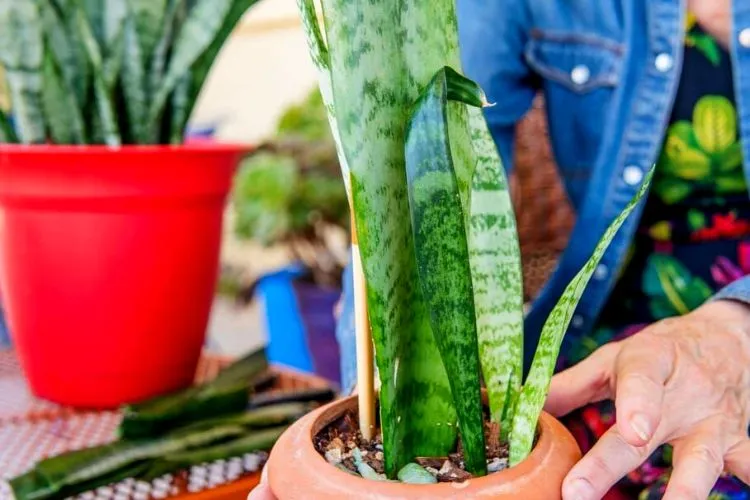
There are 4 methods you can use to propagate a snake plant. These methods are:
- Water propagation – Healthy leaves can be carefully removed and regrown using water.
- Soil propagation – Again, healthy leaves are carefully removed and rooted in a good quality soil mix.
- Propagation by division – Snake plants are really easy to divide in half and use as separate plants. The beauty of doing so is that you can remove larger, more mature sections so that they are already established. This saves a lot of growth time.
- Propagation from rhizome – Quite often, stems growing under the soil can pop up out of the soi and grow into brand new snake plants. These can then be removed and transplanted at will.
Training snake plants to grow taller
The best methods of ‘training’ involve simply giving the snake plant everything it needs to grow without being hindered by poor conditions.
This includes adequate light, air flow, drainage, a good quality soil, appropriate watering, protection from the elements, maintenance pruning, etc. These types of succulents grow directly upwards so they don’t need any kind of bounding or trellis to climb.
Tips for successful snake plant propagation
The easiest way to propagate a snake plant is by doing the following:
- Make clean cuts – Use a sharp, clean tool such as a knife or pair of scissors/gardening shears. Cut the leaves straight and avoid any jagged edges.
- Use a root hormone – Not everyone has this luxury but if possible, get some good quality root hormone to enable the process to begin from the very second that it is applied. This will help roots to form from most plant leaves, twigs, branches, etc.
- Leaf Orientation – Snake leaves are highly polar and need to be planted in the same way they were removed. So you need to remember and make sure that it is facing the right way up or down on the right side of the leaf to ensure that it will root from that area.
- Cutting V’s – Cutting the area where the root hormone is to be added in the shape of a V will increase its chances of forming roots.
- Choose an appropriate container – Snake plant leaves can be quite heavy so using taller jars/vases are more effective than short, wide jars. This will allow them to stand upright without falling over.
- Wait it out – Snake plants are painful to watch grow, they can take up to 2 months before any signs of roots begin to poke through. So, don’t be discouraged, just ride it out and let it go through the process.
Ensure Plenty of Space to Grow
Snake plants can grow up to 12 feet tall and 10 feet wide once fully mature. So, if you’re planning to just let them go for it without putting any thought into pruning then you want to allow them a bit of space to do so.
Window sills are a great option, especially those that are deep and tall. That way, they receive both adequate light and room to grow.
Frequently Asked Questions (FAQs)
What are the best tall growing snake plant species?
The Sansevieria Bacularis grows as much as 4-6 ft (1.2-1.8m) tall, The Sansevieria Stuckyi can reach anywhere up to 3-7 ft ( 0.9-2.15m) and the Sansevieria Cylindrica has been noted as reaching 6-7 ft (1.8- 2.15m) in height
How long does it take for a snake plant to grow tall?
If grown under strict but optimal conditions, many of the larger growing snake plant species can grow about 4-12 inches (10-30cm) per year. Given that some species max out at 6-7 ft (1.8-2.15m), they can usually reach those heights in around 7 years.
How tall can Indoor snake plants get?
Some species of snake plants can grow as tall as 6-7 ft (1.8-2.15m) when grown in optimal conditions.
Conclusion:
Depending on the species, snake plants will grow as tall 6-7 ft (1.8-2.15m) tall if exposed to conditions that favor it. They prefer lots of direct sunlight with respite from extreme colds and heats when those conditions prevent themselves.
They should never be overwatered, or ever hardly watered for that matter as they absorb the majority of their moisture from the surrounding atmosphere.
Snake plants are definitely one of those plant species that you want growing away in the background as they have an uncanny ability to purify the air from a range of toxins and impurities. The beauty of them is that they are extremely easy to grow and maintain up to the height you desire, they may just take some time.
We hope that this guide has been helpful. You can read about similar topics here on our website. Check back again soon for more.


